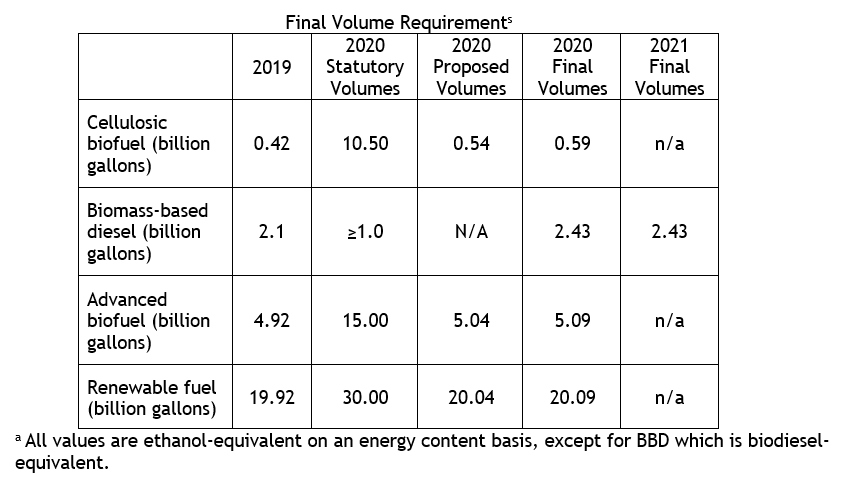EPA Fulfills Another Trump Administration Promise
the U.S. Environmental Protection Agency (EPA) finalized a rule that establishes the required renewable volumes under the Renewable Fuel Standard (RFS) program for 2020, and the biomass-based diesel volume for 2021. Through this action, the Trump Administration has fulfilled yet another key promise to the American people, American farmers and American biofuels producers by increasing biofuels volumes under the renewable fuel standard and modifying the program requirements to ensure those volumes are met. The EPA is committed to ensuring a net of 15 billion gallons of conventional biofuel is blended in 2020.
“Through President Trump’s leadership, this Administration continues to promote domestic ethanol and biodiesel production, supporting our Nation’s farmers and providing greater energy security,â€Â said EPA Administrator Andrew Wheeler. “President Trump committed to our nation’s farmers that biofuel requirements would be expanded in 2020. At the EPA we are delivering on that promise and ensuring a net of 15 billion gallons of conventional biofuel are blended into the nation’s fuel supply.â€
Under the Trump Administration, EPA has consistently increased the renewable volume obligations and continued to expand the nation’s renewable fuels sector. Through this rule, EPA has modified the RFS program by projecting small refinery relief to ensure that these final volumes are met, while adjudicating small refinery relief when appropriate. As proposed, we are finalizing a projection methodology based on the 2016-2018 annual average of exempted volumes had EPA strictly followed the Department of Energy (DOE) recommendations of 770 million Renewable Identification Numbers (RINs) in those years, including granting 50 percent relief where DOE recommended 50 percent relief. This is our general approach to adjudicating Small Refinery Exemption (SRE) petitions going forward, beginning with 2019 SRE petitions and including 2020 SRE petitions and beyond, we are committed to following the DOE recommendations. By proposing effectively 15.8 billion gallons for 2020 we will ensure meeting our target of 15 billion gallons.
The key elements of today’s action are as follows:
- “Conventional†biofuel volumes, primarily met by corn ethanol, will be maintained at the 15 billion gallon target set by Congress for 2020.
- Cellulosic biofuel volumes for 2020, and thus advanced biofuel volumes, will increase by almost 170 million gallons over the 2019 standard.
- Biomass-based diesel volumes for 2021 will be equivalent to the standard for 2020, still more than double the statutory requirement.
- EPA will closely examine the labeling requirements for E15 fuel and move forward with clarifying regulations as needed.
- EPA has modified the way RFS obligations are determined to better ensure that these volumes are met, while still allowing for relief for small refineries consistent with the direction provided by Congress under the statute. By proposing effectively 15. 8 billion gallons we will net out at 15 billion.

This final rule is the latest in a series of steps the Administration has taken to expand domestic energy production and improve the RFS program which will help American farmers.
More information can be found here:Â https://www.epa.gov/renewable-fuel-standard-program/final-renewable-fuel-standards-2020-and-biomass-based-diesel-volume
Earlier this year, the Trump Administration made good on its promise to allow the year-round sale of E15 gasoline across the country. Building on the President’s earlier decision to allow year-round sales of E15, EPA is working to streamline labeling and remove other barriers to the sale of E15. EPA is also making important reforms to the Renewable Identification Number (RIN) compliance system to improve transparency and to deter price manipulation in the RIN market. These efforts will provide certainty and transparency to farmers and biofuel producers across the country.
Under President Trump’s leadership, EPA will continue to actively engage with stakeholders to expand the number of approved fuel pathways and add diversity to the biofuel mix in the United States. Since January 2017, EPA has approved 25 petitions for new fuel pathways, including a final rule in August 2018 that approved new pathways for biofuels derived from sorghum. EPA will continue to further explore opportunities to remove regulatory burdens that prevent marketplace entrance and growth to natural gas, flexible fuel vehicles, and E85 fuels.
Since taking office in 2017, the EPA under the Trump Administration has worked to provide long-term certainty and a workable regulatory environment for U.S. farmers and ranchers, including:
- The repeal the 2015 Waters of the United States (WOTUS) rule and proposing a more common-sense replacement.
- Ending long-standing agency practices of “sue and settle.â€
- Enhancing the agency’s partnership with agriculture stakeholders through EPA’s Smart Sectors program.
- Issuing the long-term approval for the insecticide sulfoxaflor.
- Taking steps towards re-registering the herbicide atrazine.
- Encouraging market-based water quality training.
- Signing a final rule exempting routine farm animal waste emissions from reporting under Emergency Planning and Community Right to Know Act (EPCRA).
- Approving Renewable Fuel Standard pathways for corn and sorghum oil.
- Reaffirming there is no risk to the public health when listing glyphosate as not a carcinogen.
In future, separate actions:
- EPA will take final action to address the court’s 2016 remand.
- USDA will pursue opportunities through the budget process to consider infrastructure projects that would accommodate higher biofuel blends.
The Trump Administration will continue to enact sensible regulation that improves the lives of all Americans.
HOT JOBS IN EVANSVILLE AREA
|
|||||||||||||||||||||||||||||||||||||||||||||||||||||||||||||||||||||||||||||||
|
fop article
Notes from 8/1/19 meeting with DJ Thompson, Mike Sides and Alan Yeager
- “Administration sucks. This is nothing personal against Billy.â€
- Manpower issues. Department is 18 officers short. Officers can’t get days off when they want them. – They get days off when planning ahead. No employer gives days off “whenever the employee wantsâ€
- “People are just walking out…leaving here for lesser paying police jobs.†– Who left here to what department—what were the other circumstances? Wife got new job? Went back to their home area?
- Not enough officers to do police work. Not making car stops. Not getting guns proactively off the streets.—many officers not doing proactive because line level supervisors do not make them—many hours of downtime—little to no arrests… We will always be at minimum. If we increase minimum, they will complain they can’t get a day off. If we leave it at current minimum, then they will “always be too busyâ€. The argue both sides of the coin
- Manning shortage causing psychological problems with some officers.—shifts are covered—all contractually promised days off are being given
- Keep starting new units. CPOs were doing the work that the homeless liaison officer is now doing.—CPO’s cover a lot of different issues—Karges Sr can address this
- Park liaison — Matt Karges — assigned to Mikey’s Kingdom (Billy’s project)and only answers to parks issues—Karges has 734 calls for service. Only 6 (of 33) day shift officers have more than he does
- Overtime — can’t imagine how much we spend. We will always be at minimum because officers take theie vac, fam, and comp days- and officers will always take advantage of unlimited sick days…If we moved to eliminate unlimited sick days, they would fight it
- OT is mismanaged. 911 Gives Hope…the event at Larry Bennett’s place. ZERO OT for 911 Gives hope or the event at Bennett’s.. The are being attacked because Billy is associated ..This claim is completely false
- Jeff Worthington issue…priority is to go to the media. —Media called and asked about an elected official getting suspended. Media was tipped off before agenda email went out
- Instances like JW’s creating lots of mistrust of Billy.Â
- 70%-80% of officers don’t trust him. Where did this number come from?
- Sense that he’s absent a lot. He gets his time off just like everyone else
- “to be on the department now sucks.†Common feeling. Emotion based—can’t respond to it
- People are afraid to do their jobs…afraid administration won’t back them up. The admin has backed up officers time and time again, The FOP has been silent on every shooting, social media attack…
- New operational guidelines on officer involved shootings. Andy reply
- New OG requires involved officer(s) to make full statement/interview immediately for the sake of media. Very basic info- “ I saw this and fired my†gun..Vegas based video
- When new OG was rolled out, administration stated that it had been approved by the FOP attorney, which was false.
- Rush to the media to release information. More worried about media than officer safety.Not sure what tney are referring to
- Vehicles…not enough of them. Officers are waiting an hour after roll call to get a car.—When did this happen and how often
- Fewer and fewer cars are on the streets.—
- Testing process…they would like feedback on oral portion of exams. In other words, identify areas for improvement.
- Deputy Chief Brush and Lt. Hahn have relatively little to do for their ranks.
- Body cams. Concerned about restroom breaks being recorded.—Then ensure you are not recording before you walk in
- Concerned about the fishing expeditions of supervisors.—Have they found an example?
- VIPER moved to report directly to the Chief. It’s “his private militia.â€
- “Communication is lacking.†(from Chief)
- Chief avoids eye contact at roll call and when walking through roll call area.
- Doing the job is becoming miserable.
- Administration is setting officers up to fail.—In what way- specific examples
- Officers of the FOP are targeted for their union activity. Who?Â
Senator Braun’s Statement on the Impeachment of President Donald Trump
Senator Braun released the following statement on House Democrats’ impeachment of the 45th President Donald J. Trump.
“Record high in the stock market, historically low unemployment, USMCA, China Phase 1, ISIS leaders dead, building the border wall and so much more. President Trump is right – this doesn’t feel like impeachment. It feels like WINNING for the American People!” – Senator Mike Braun
“IS IT TRUE” DECEMBER 19, 2019
We hope that today’s “IS IT TRUEâ€Â will provoke honest and open dialogue concerning issues that we, as responsible citizens of this community, need to address in a rational and responsible way?
IS IT TRUE that the Harvard Business School just released a study that assesses the competitiveness of the United States of America?…in this study, it states that in 1964 a full 77% of the population trusted the federal government to do the right things to make progress happen and that today only 17% of Americans trust the federal government?…that has increased from a low of 15% in 2009?…one could almost surmise that with that low of a number trusting the federal government that it can’t go much lower since roughly 15% believe silly things like Elvis is alive and Hitler is living in Argentina plotting a return to power?
IS IT TRUE that this same study has addressed the political affiliation changes of Americans since 2004 that happened to be the year that President Reagan was re-elected?…in 2004 the political affiliation of Americans was 34% Democrat, 34% Republican, and 31% Independent?…that in 2008 when President Obama was elected Independents passed both Democrats and Republicans and the lead of Independent affiliation has continued to grow unabated?…today 41% of Americans identify as Independent while 30% identify as Democrats and 28% as Republicans?…the source of this data was taken from historical Gallup polls and indicates a rising disenchantment for political affiliation of any kind?…at the current growth rates by 2030 there will be a majority of Americans who do not identify with either the Democrat or Republican parties?…this will be a good thing as both parties have so corrupted themselves with self-interest and identity politics that neither deserves to be in a position of control?
Indiana Sees Revenue Surplus In November, Sports Betting Profits On The Rise
By Emily Ketterer
TheStatehouseFile.com
INDIANAPOLIS –– Indiana continues to bring in more money than expected each month so far this fiscal year, including more than $880,000 in November sports wagering tax revenue.
The state’s general fund revenue for November reached a little more than $1.1 billion, which is $53.6 million above the adjusted revenue forecast presented in April.Â
State Budget Director Zachary Jackson said the extra money comes from a number of factors and no particular outlier. He said the economy is good right now and the state’s three major sources of revenue––sales tax, personal income and corporate income––are all doing better than expected so far.
“The revenue forecast is just that, it’s a forecast, and therefore, fluctuations are typical and anticipated,†Jackson said. The fiscal year ends June 30.
In addition, sports wagering in the state just finished its third month at the end of November. Hoosiers placed nearly $150 million in sports bets during the month, an increase from the $91.7 million in bets placed during October.Â
Those bets resulted in more than $880,000 in tax revenue for the state. And $9.3 million was collected in taxable adjusted gross revenue, according to the state report. Jackson said the tax revenue is an increase from the estimated $0.6 million expected in November.
Since legal sports wagering went live for the first time in September, more than $270 million in bets were made, which made the state $2.7 million in total tax revenue.
And Frank Ignatius, president and founder of BetIndiana, said the state can expect those revenue numbers to get even higher in the near future.
“This is probably one of the lower Novembers we will ever have,†Ignatius said. “This industry is still very much in its infancy, and I think there’s a lot of room for growth.â€
He said researchers predict Indiana sports wagering will be worth about $300 million per year in revenue, which translates to about $30 million in annual tax revenue.Â
Also, 65% of all sports wagering in November came from mobile bets. Ignatius expects at least 90% of bets to be mobile within the coming months.
To see how the state stacked up against others, Ignatius compared Indiana to New Jersey, which is in its 16th month of legal sports wagering. New Jersey just broke the record for the total handle at $560 million collected in November. He said he sees this as a prediction for Indiana’s future in sports wagering.Â
“They’re a much more mature market than Indiana,†Ignatius said. “But the point is, compared to the research numbers, New Jersey is surpassing what even the researchers suggested.â€
He said Indiana is off to a great start.
“I mean their numbers have been better than most states in early months,†Ignatius said. “This is very encouraging for the future of Indiana sports betting. I think it’s going to be one of the top markets in the country.â€
Although revenue coming in from sports wagering is exceeding forecasts, Jackson said the money only puts a small dent in the total revenue collected from state taxes.
“Given that we have collected over $6.26 billion in general fund revenues so far this fiscal year, the revenue impact of sports wagering, whether looking at the projections or actuals, is comparatively small,†Jackson said.
The updated revenue forecast for this fiscal year will be presented on Friday.
Indiana ended the last fiscal year with a record-high $2.27 billion in reserves, and the state continues to bring in money exceeding the revenue forecast. In July, Gov. Eric Holcomb asked that $300 million of that extra money be used for one-time capital projects already approved by the General Assembly:
- $73 million, Purdue College of Veterinary Medicine teaching hospital;
- $60 million for the Ball State University STEM and Health Professions facilities;
- $50 million, Fall Creek Pavilion at the Indiana State Fairgrounds; andÂ
- $30 million for the Ivy Tech Columbus main building replacement.
Holcomb will also ask the General Assembly to use funds for existing projects, including $48 million for the University of Southern Indiana Health Professions classroom renovation, and paying off existing debt obligations early for state facilities such as hospitals, prisons, and parks.
The governor has said paying for these projects now will save the state more than $125 million.
However, the Indiana State Teachers Association asked for $75 million to go to teacher salary raises. Holcomb did not set aside any reserve money to go toward this request.Â
Democratic candidate for governor, Sen. Eddie Melton of Gary, who has been an advocate for teacher pay raises during his campaign, announced a bill that would take $100 million over the biennium for teacher pay increases.
“This would put money in teachers’ pockets next year, something Republicans have said isn’t possible,†Melton said. “I assure you, if it’s a priority, it can be done.â€
FOOTNOTE: Emily Ketterer is a reporter for TheStatehouseFile.com, a news website powered by Franklin College journalism students.






